Victorian Dairy Soils - Dermosols
Back to: Victorian Dairy Soil
Dermosols are structured soils that lack strong texture contrast between surface (A) horizons and subsoil (B) horizons.
Distribution
| In Gippsland, Acidic Brown and Grey mottled Dermosols have developed on the strongly dissected rolling hills of the Strzelecki Ranges. They are characterised by a lack of strong texture contrast, and are strongly acid throughout the profile. Weathered Cretaceous sandstone and mudstone usually occurs before 1.5 metre depth. Similar soils are also common on many of the steep slopes of the Otway Ranges. Soil Pit Site SG12 is an example of a Brown Dermosol near Fish Creek in Gippsland. | 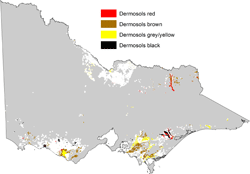 |
| Black Dermosols have developed on more recent alluvial sediments associated with the Thomson, Macalister and Avon floodplains. They lack strong texture contrast and are very strongly structured and permeable. Soil Pit Site GP73 is an example of an alluvial Black Dermosol near Maffra. Black and dark Grey Dermosols have also developed in former swamp deposits to the north and east of Koo Wee Rup. Soil Pit Site GP26 is an example of a dark Grey Dermosol near Catani. | 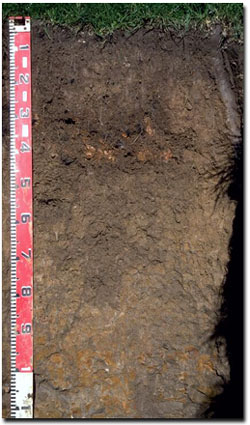 Brown Dermosol near Fish Creek in West Gippsland | 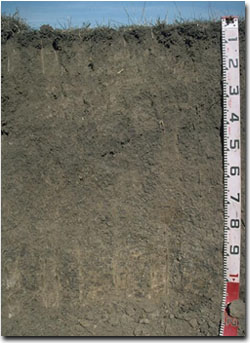 Black Dermosol developed on alluvium near Maffra |
| Black and Brown Dermosols occur on volcanic ash and scoria deposits in South West Victoria, including the Alvie and Warrnambool districts. These soils are very well structured and drained. Soil Pit Site SW26 is an example of a Black Dermosol developed on volcanic ash near Camperdown. Soil Pit Site SW8 is an example of a Brown Dermosol developed on volcanic ash deposits near Alvie. | 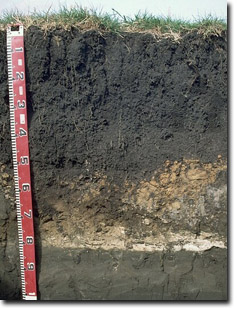 Example of a Black Dermosol developed on volcanic ash deposits | 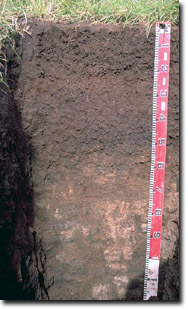 Brown Dermosol near Alvie, developed on volcanic ash deposits |
| In north-east Victoria, Red Dermosols are common on older river terraces and alluvial fans of river valleys. In higher rainfall areas these soils are typically strongly acid throughout. Soil Pit Site NE19 is an example of a Red Dermosol in the Tallangatta Valley. In south-west Victoria, small areas of Red Dermosols occur on Port Campbell Limestone deposits in the Jancourt area and are less acidic. Soil Pit Site CSLP2 is an example of a Red Dermosol near Jancourt. | 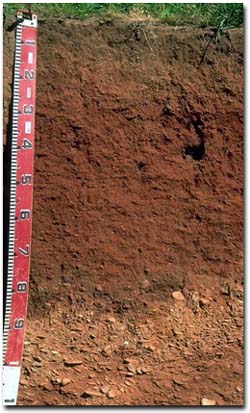 Red Dermosol on river terrace in the Tallangatta Valley in north-east Victoria |
| Yellow and Grey Dermosols developed on gently undulating rises and plains in West Gippsland (on Cretaceous sediments in the Athlone-Nyora area and on Tertiary sediments in the Willow Grove-Westbury area). Soil Pit Site GP18 is an example of a Grey Dermosol near Darnum. North of the South Gippsland uplands are low hills and undulating rises comprising Neogene and Palaeogene aged (Tertiary) sediments which were deposited as fans and aprons of gravel, sand and clay derived from the Central Highlands. The soils on these Tertiary hills and rises are typically Yellow and Grey Dermosols. They are generally strongly leached, lack strong texture contrast between the surface and subsoil horizons and are acidic throughout the profile. Below the clayey subsoil, the underlying material is quite variable and ranges from sandy clays to cemented sands and gravels. In south-west Victoria, Yellow and Grey Dermosols have developed on Gellibrand Marl (e.g. Cowleys Creek area) and are usually clay loams grading to clays and can be calcareous at depth. Soil Pit Site SW51 is an example of a Grey Dermosol near Cooriemungle. Grey Dermosols developed on Hanson Plain Sand (e.g. Simpson area) are lighter in texture (e.g. fine sandy loams grading to light clays at depth) and very strongly acidic throughout. Soil Pit Site SW21 is an example of an Acidic Grey Dermosol near Simpson. | 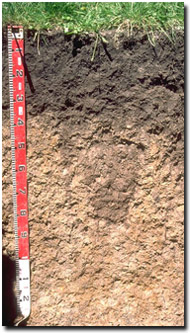 Grey Dermosol near Willow Grove in West Gippsland |
Management Considerations
Dermosols in general are relatively well drained due to the gradational soil profile and are usually well structured. This allows more effective profile drainage and root movement compared to texture contrast soils.
Black Dermosols
Black Dermosols associated with scoria and volcanic ash deposits in South West Victoria are friable when moist and very well structured. Due to the relatively high clay content in the surface horizon, such soils may be prone to compaction if excessively disturbed (e.g. cultivation, trafficking) whilst in a moist-wet condition (i.e. wetter than the plastic limit). Some also tend to be relatively high in free iron oxide which can result in P being tightly bound. The surface soil and upper subsoil is strongly structured (parting to many fine polyhedral shaped peds) and will provide a good environment for roots and promote relatively rapid water movement.
Black Dermosols on alluvial sediments in West Gippsland can have acidic surface horizons. A pH/aluminium test is best performed from samples taken across the paddock and bulked together. Other factors also need to be considered before lime is recommended (e.g. pasture species grown, method of application, local trial responses, soil surface structure and likely cost/benefit). The surface and upper subsoil horizons are friable and well-structured which promotes root and water movement into the profile.
Black Dermosols in the former swamp deposits near Koo-Wee-Rup are generally strongly acid throughout and aluminium and manganese levels can be high. A lime test (sampled across the paddock) may be appropriate to determine the amount of lime needed to raise pH levels. Other factors need to be considered, however, before lime is recommended (e.g. species grown, method of application, local trial responses, likely cost-benefit). Molybdenum deficiency may occur in the strongly acid surface soil and manganese toxicity can also occur, especially when waterlogged. Lime application will make molybdenum more available to plants. However, if a deficiency occurs it may be more practical to apply a molybdenum compound to the soil or pasture. The levels of organic carbon levels are also high which is important for maintaining soil aggregation as well as fertility and water holding capacity. PAWC is relatively high in the surface horizons. Organic materials have been known to be effective in reducing the level of active aluminium in soils.
Red Dermosols
Red Dermosols are generally reasonably well drained. In north-east Victoria they tend to be strongly acid in higher rainfall areas and as a result aluminium and manganese toxicity may occur. A pH/aluminium test on a bulked sample taken from across the paddock would be most appropriate for determining how much lime is needed to raise soil pH. However, other factors need to be considered before lime is recommended e.g. pasture species grown, method of application, local trial responses, likely cost/benefit.
Small areas of Red Dermosols in the Jancourt area are very well structured and drained and have inherently high fertility. They are generally not strongly acidic (and become alkaline at depth). They have high clay content in the surface soil and can be prone to compaction when trafficked or over-stocked when moist.
Brown Dermosols
The Acidic Brown Dermosols associated with steep hills in the Strzelecki and Otway Ranges are generally strongly acid. In strongly acid soils, levels of exchangeable aluminium can become high which can affect the growth of aluminium sensitive species (e.g. phalaris, medics, sub clover, white clover and tall fescue). A pH/aluminium test sampled across the paddock level may be appropriate to determine lime requirements. Other factors need to be considered before lime is recommended (e.g. pasture species grown, method of application, local trial responses, soil surface structure and likely cost/benefit). Also, in strongly acid surface soils, deficiencies in molybdenum and phosphorus may occur. High levels of exchangeable aluminium will tend to "fix" phosphorus and make it unavailable to plants. Increasing soil pH (by the addition of lime) enable phosphorus (from phosphorus application) to be more readily available. On steep slopes, lateral movement of water is likely to occur above the bedrock - which may precipitate soil slumping. In shallow drainage lines, tunnel erosion may occur just above the bedrock. Ultimately, these tunnels may collapse to form gullies.
Grey and Yellow Dermosols
Yellow and Grey (mottled) Dermosols are generally not as well drained as their browner and redder counterparts, so waterlogging and pugging can be a major issue in wet years.
Dermosols developed on gently undulating rises and plains in West Gippsland (on Cretaceous sediments in the Athlone-Nyora area and on Tertiary sediments in the Willow Grove-Westbury area) are typically strongly acid throughout and have relative low inherent fertility. Exchangeable aluminium and manganese levels can be high and liming is usually beneficial in such cases. A pH/aluminium test on a bulked sample taken from across the paddock would be most appropriate for determining how much lime is needed to raise soil pH. However, other factors need to be considered before lime is recommended e.g. pasture species grown, method of application, local trial responses, likely cost/benefit.
In south-west Victoria, Yellow and Grey Dermosols on Gellibrand Marl (e.g. Cowleys Creek area) are usually strongly acidic and exchangeable aluminium levels can be high. A pH/aluminium test on a bulked sample taken from across the paddock would be most appropriate for determining how much lime is needed to raise soil pH. The major physical limitation of these soils is their severe winter waterlogging in wet years that can result in major pugging to pastures grazed by cattle in winter. This winter pugging seriously reduces the growth rates and utilisation of the pasture, degrades the pasture composition, and damages the soil structure.
Grey Dermosols on Hanson Plain Sand (e.g. Simpson area) are very strongly acidic and have very low inherent fertility below the organic rich surface horizon. For all these soils, a pH/aluminium test on a bulked sample taken from across the paddock would be most appropriate for determining how much lime is needed to raise soil pH. However, other factors need to be considered before lime is recommended e.g. pasture species grown, method of application, local trial responses, likely cost/benefit. Being low in fertility these soils respond well to fertiliser. Some trace element deficiencies are likely. The lighter-textured (i.e. sandy loam) surface soils allow plants to respond better to lower rainfall events than the heavier textured surface soils in the region.


